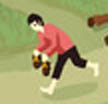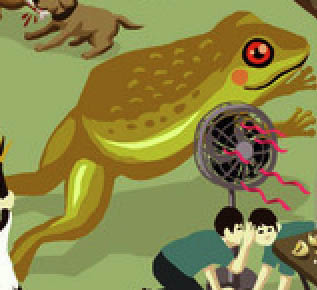Eighty-one Cantonese proverbs in one picture
« previous post | next post »
From the "Cantonese Resources" blog:
Ah To 阿塗, a graphic designer and part-time cartoonist who is concerned about the survival of Cantonese in Canton and Hong Kong, has just published a comic called "The Great Canton and Hong Kong Proverbs" on Hong Kong independent media "Passion Times".
From this Breughelian painting and the accompanying explanations, you can get a sense of what Cantonese language, culture, and society are like. By doing so, several things become immediately evident:
- Cantonese is a real language, not some disembodied "dialect" or slimy "slang" — terms which are often applied to Cantonese by people who are ignorant of its true nature.
- Cantonese is a vivid, imaginative language full of colorful expressions that cannot be found in other Sinitic languages.
- Cantonese phonology, lexicon, grammar, and orthography are different from those of Mandarin; Cantonese and Mandarin are separate languages.
We have often written on these topics here at Language Log, e.g.,
- "Spoken Hong Kong Cantonese and written Cantonese"
- "Cantonese as Ebonics"
- "Is Cantonese a language, or a personification of the devil? "
By way of illustration, here are just a couple of the proverbs depicted by Ah To. The Chinese characters are transcribed In Yale romanization.

冇鞋挽屐走 [móuh hàaih wáan kehk jáu]
(where there are no shoes, grab the clogs and run)
to withdraw hurriedly from an awkward situation

咁大隻蛤乸隨街跳 [gam daaih jek gap lá chèuih gāai tiu]
(such a big frog hopping around the street)
too good to be true
If you want to learn more about Cantonese in the flesh, you could do worse than study Ah To's painting for a day or two.
[Hat tips to Annie Chan, Norman Leung, Wicky Tse, Tim Chan, and John Rohsenow]

Emily said,
February 27, 2014 @ 11:55 am
An earlier example of this genre is T. E. Breitenbach's Proverbidioms:
http://en.wikipedia.org/wiki/Proverbidioms
Levantine said,
February 27, 2014 @ 2:03 pm
It seems to me that this is at least partly inspired by Pieter Bruegel's wonderful painting Netherlandish Proverbs (http://en.wikipedia.org/wiki/Netherlandish_Proverbs).
Levantine said,
February 27, 2014 @ 2:46 pm
Ah, and I just realised I missed the reference to Bruegel in the original post, for which I apologise.
Stephan Stiller said,
February 27, 2014 @ 2:53 pm
@Levantine
It is; the source says so.
I hope that I can buy this as a poster some day.
Levantine said,
February 27, 2014 @ 2:55 pm
Stephan Stiller, thank you. I should have paid more attention to the post and its links.
Rubrick said,
February 28, 2014 @ 3:01 am
Wait, is that a musical score I see on that elephant's backside…?
Ray Dillinger said,
February 28, 2014 @ 12:44 pm
Being unfamiliar with Cantonese proverbs, I can't identify these without a cue card. Is there a complete list somewhere?
Levantine said,
February 28, 2014 @ 3:23 pm
Ray Dillinger, if you follow one of the links given in the post, you'll find a fun and useful breakdown. I was surprised by how many of the proverbs involve ghosts.
wl said,
March 1, 2014 @ 4:19 am
this "ah to" is the one who creates "golden creatures" in golden forum (HK)? "why so serious" icon is on the top!
Coco said,
March 1, 2014 @ 10:41 am
Yes, this Ah To is the creator of Golden creatures, later draw comics with Golden Creatures characters. You may find more of his work in the link below, though mostly are in Chinese,
https://www.facebook.com/Artohk
Chaaak said,
March 1, 2014 @ 12:54 pm
Actually there are 83 of them in total. Ah To missed out two initially.
You can find the solution here, with explanations in English:
http://writecantonese8.wordpress.com/2014/02/25/cantonese-proverbs-in-one-picture/
@Stephan Stiller
I'm sure many Cantonese lovers would want a poster of it. Let me check with Passion Times and Ah To. I will keep everyone posted.
@Victor Mair
Thank you for posting this to Language Log.
Cantonese is dying out even in Hong Kong. Chinese classes are taught in Mandarin instead of Cantonese in 70% primary schools. The government is trying to convince the population not to speak Cantonese to their kids. We are trying very hard to fight back. It's good to know that we are not alone.
Horara FUN said,
March 2, 2014 @ 7:55 am
I want to share with you my notes on why Cantonese, the oldest Chinese language survived, is a language which have over 2000 years of history and civilization. It is far richer than Mandarin which is blow 400 years old. The only issue is that it is in Chinese:
https://www.facebook.com/notes/horara-fun/%E7%94%9A%E9%BA%BC%E6%98%AF%E6%96%B9%E8%A8%80/10151988199798668
Olly Richards said,
March 22, 2014 @ 2:11 pm
I was in Hong Kong recently and everyone was talking about this. I hope there's a poster version made at some point!
I've been learning Cantonese for about 6 months now and I'm in love with the language. This really epitomises the richness and humour of Cantonese and it's shocking to think that it might be under threat from some quarters.
Great work on the blog!
Victor Mair said,
March 22, 2014 @ 2:42 pm
There's now an article by Ben Sin about it in SCMP:
http://www.scmp.com/lifestyle/family-education/article/1450856/hongkongers-take-steps-preserve-their-language-and
HKer said,
August 2, 2014 @ 3:29 am
The printed poster is published. Check this out.
http://www.passiontimes.hk/?view=regform#others
There are even more HK Cantonese proverbs added in the printed version.